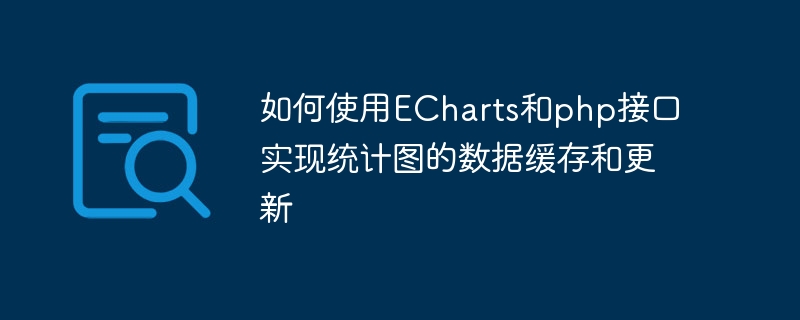

How to use ECharts and php interface to implement data caching and updating of statistical charts
In web applications, statistical charts are often used to display data analysis results. ECharts is a popular open source JavaScript charting library that can help us create various types of interactive statistical charts. However, fetching data directly from the database and rendering charts may cause performance issues when the amount of data is very large or the data is updated frequently. In order to solve this problem, we can use the PHP interface to implement data caching and updating of statistical charts.
1. Data caching
<?php
// 连接数据库
$connection = new mysqli("localhost", "username", "password", "database");
// 查询数据库获取统计数据
$query = "SELECT * FROM statistics";
$result = $connection->query($query);
// 将查询结果转化为json格式并保存到缓存文件中
$data = [];
while($row = $result->fetch_assoc()) {
array_push($data, $row);
}
$json = json_encode($data);
file_put_contents("cache.json", $json);
// 关闭数据库连接
$connection->close();
?>$.ajax({
url: "api.php",
dataType: "json",
success: function(data) {
// 数据获取成功后,使用ECharts绘制统计图
var chart = echarts.init(document.getElementById('chart'));
// 基于获取的数据进行统计图的配置
var option = {
// 配置项...
series: [
{
type: 'bar',
data: data
}
]
};
// 渲染统计图
chart.setOption(option);
},
error: function() {
// 数据获取失败时的处理逻辑
}
});$(document).ready(function() {
$.ajax({
url: "api.php",
dataType: "json",
success: function(data) {
var chart = echarts.init(document.getElementById('chart'));
var option = {
// 配置项...
series: [
{
type: 'bar',
data: data
}
]
};
chart.setOption(option);
},
error: function() {
// 数据获取失败时的处理逻辑
}
});
});2. Data update
<?php
// 连接数据库
$connection = new mysqli("localhost", "username", "password", "database");
// 接收前端传递的新数据
$newData = $_POST['data'];
// 将新数据更新到数据库中
$query = "UPDATE statistics SET data = '$newData' WHERE id = 1";
$result = $connection->query($query);
// 更新成功则返回成功标识给前端,否则返回失败标识
if($result) {
echo "success";
} else {
echo "failure";
}
// 关闭数据库连接
$connection->close();
?>$("#updateButton").click(function() {
// 获取待更新的数据
var newData = // 获取新数据的方法,如用户输入或通过其他接口获取
// 发送请求到php接口
$.ajax({
url: "update.php",
type: "POST",
data: {
data: newData
},
success: function(response) {
if(response === "success") {
// 更新成功后的处理逻辑
alert("数据更新成功");
} else {
// 更新失败后的处理逻辑
alert("数据更新失败");
}
},
error: function() {
// 请求失败后的处理逻辑
}
});
});The above code example is a simple example of data caching and updating of statistical charts based on ECharts and php interfaces. In practical applications, it can be modified and expanded according to specific needs. Through data caching and updating, we can improve the performance and user experience of statistical charts, allowing users to obtain the latest data analysis results in a timely manner.
The above is the detailed content of How to use ECharts and php interface to implement data caching and updating of statistical charts. For more information, please follow other related articles on the PHP Chinese website!